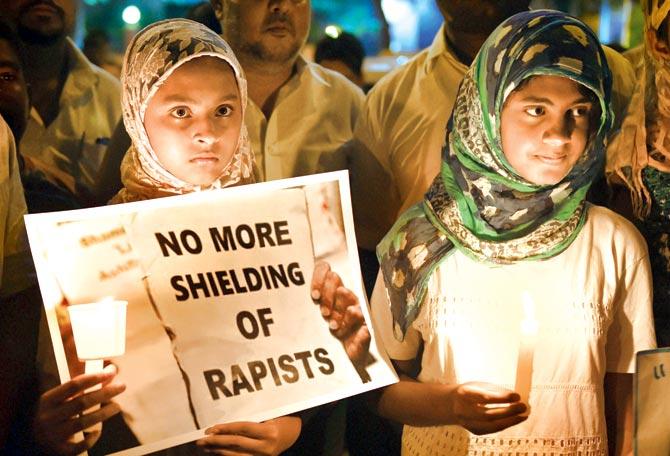In the aftermath of an eight-year-old's brutal rape and murder, fake news constructs a narrative dominated by lies and half-truths


Girls at a candle light vigil in Bengaluru against the Kathua rape and murder. PIC/PTI
ADVERTISEMENT
 As the outrage erupted last week over the rape and murder of an eight-year-old girl of Jammu and Kashmir's nomadic Bakerwal tribe (which happened in January), BJP supporters floated a justification for the barbaric act. A stunning aspect of the case – alongside the detail in the police chargesheet that an accused raped the little girl "one last time" before they killed her – was a protest march in support of the rapists-murderers. This despite the accused having confessed their crime.
As the outrage erupted last week over the rape and murder of an eight-year-old girl of Jammu and Kashmir's nomadic Bakerwal tribe (which happened in January), BJP supporters floated a justification for the barbaric act. A stunning aspect of the case – alongside the detail in the police chargesheet that an accused raped the little girl "one last time" before they killed her – was a protest march in support of the rapists-murderers. This despite the accused having confessed their crime.
Even the tricolour was waved during this protest, merely to communalise the crime between patriots and "anti-nationals". After all this the justification began emerging on social media, comprising a single word: Rohingya. The rest was left to lurid nativist paranoia. A narrative emerged, according to which a communal chasm opened up in Jammu due to the influx of Rohingya Muslim refugees who escaped the genocide in their homeland by the Myanmar army. (Nobel laureate Aung San Suu Kyi kept quiet on it for political expedience, leading to scattered calls for withdrawing her Nobel Peace Prize.) Some extrapolated this narrative to talk of "jehadi Rohingyas" and one genius even claimed the PDP had surreptitiously settled these "jehadi Rohingyas" in Jammu for demographic change in what is still a Hindu-majority city.
Fact 1: The rape-murder had nothing to do with Rohingya Muslims. Fact 2: The criminals were caught and have confessed. Fact 3: The home ministry says there are 7,000 Rohingya Muslims in Jammu. Fact 4: Jammu town's population is nearly 5 lakh, while the entire Jammu division population comes to around 60 lakh. Fact 5: Kathua, the scene of the ghastly crime, is 100 km from Jammu.
Fake news, as we know, exploits people's ignorance about a distant place (or time), crunching 100-km distances to a single point, and it constructs a narrative dominated by lies and half-truths which convince, on the scaffolding of the few facts that are actually used, the easily-persuaded. For many Indians, Kathua and Jammu might be side-by-side in the way that many imagine Muzaffarabad and Peshawar or Arunachal Pradesh and Tripura to be side-by-side. Many Vaishno Devi pilgrims have never seen Kathua. Thus, any manufactured fact about Jammu is readily tacked onto Kathua.
Seven thousand refugees can never demographically change bustling Jammu. It is a bogey. Rohingya Muslims are scattered around India in an even more impoverished state than Bangladeshi migrants. Bangladeshis in Gurgaon live in pitiable slums, in sub-human conditions. The Rohingyas are worse off. They struggle to eat, and have no time for jehadi nonsense. It is but a Hindutva wet dream. The rape-murder itself shines light on larger as well as local factors. The Bakerwal nomads have caught up with the 21st century, and a social change they face is of their children getting educated; they don't want the nomadic life. The youngsters are getting atomised and settling down around the state, like lawyer Talib Hussain, 29, a Bakerwal settled in Kathua who was recently jostled by BJP supporters on TV.
One of the BJP state ministers who attended the pro-rapist rally and was dropped by the PDP-BJP coalition government is Lal Singh. He used to be a Congress MP during the UPA-1 and UPA-2 decade. The Congress didn't contest him in 2014 so he joined the BJP (unsurprisingly: over 80 of the BJP's MPs are professional turncoats.) Why did he go out of his way to support the rapist-murderers? It is alleged that he wants to grab the land that Bakerwals traditionally grazed on, and so supports their ejection once and for all. The rapist-murderers have confessed that their beastly crime was meant to scare the Bakerwals away from their area.
Another "fact" BJP supporters have thrown about as part of their "whataboutery" defence of the accused is of several unconnected rapes that over the recent year took place in Assam. The perpetrators are Muslims and the victims young Hindu girls. These are definitely terrible crimes. But no one took out a rally to support these rapists; indeed, mobs of their own community attacked the accused's houses (the attackers might have been motivated by self-preservation, but so what?). There was no candlelight march for these victims because one, the law did its job; and two, no one needlessly communalised the matter.
We perhaps should thank Prime Minister Narendra Modi for finally speaking out about the injustice to the little victim. He has however tried to have it both ways: his initial silence signalling his endorsement of the Rohingya conspiracy-theorists, etc. He probably realised that with the Karnataka assembly election in less than a month, he cannot afford to have both Dalit opinion and women's anger against him. His words are merely an electoral calculation, not expressed in the kind of anguish his predecessor Manmohan Singh expressed after the 2012 Nirbhaya rape-murder. No one is fooled.
Aditya Sinha's new book will be out in May. He tweets @autumnshade Send your feedback to mailbag@mid-day.com
 Subscribe today by clicking the link and stay updated with the latest news!" Click here!
Subscribe today by clicking the link and stay updated with the latest news!" Click here!







